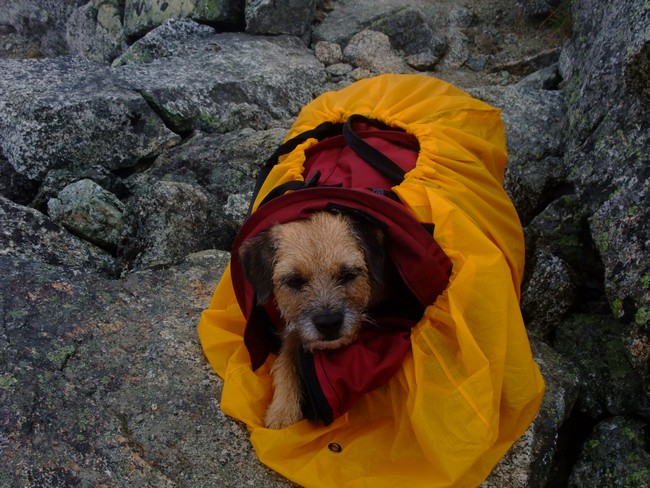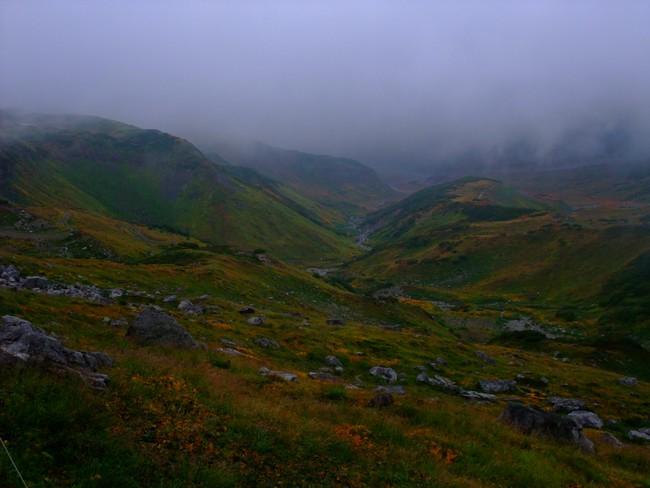Suishodake had looked so very inaccessible since Hana’s bloodied feet had forced us to abandon an attempt two weeks ago. No matter how long I looked at the map, no short route magically appeared. It was going to be a long, long day.
And that meant travelling light. No tent, just a bivvy at Kagamidaira as cjw had recommended. But not even the bivvy happened as planned, for upon arrival at Shin-Hotaka at 9 pm, the rain was falling and I could not face setting off, alone in the dark through the rain for this hideously long hike. I slept fitfully in the car, nervous about the pain that was coming.
We were off soon after 1 am. The radio I had brought for company quickly died. The gravel road to Wasabi-daira gave way to a well-marked trail, with the headlight picking out the freshly-painted white circles on the rocks. The temperature began to fall dramatically, unreasonably. Just beyond Kagamidaira, I kept imagining that I was seeing animal eyes reflecting in the forest, then I realised with horror that it was ice. A fine film of ice crystals covered the leaves. Damn. My crampons were in the car.
By the time we reached the Sugoroku hut after 5, the snow was still only a centimetre deep, but the wind was howling and devastatingly cold. We could not take refuge in the hut, but the door to the storeroom for diesel cans was not locked, so I crept in, crawled into a lightweight 3-season bag, stuffed the dog inside, and we both shivered uncontrollably until dawn.
First light always revives the spirit, that and the sight of other tracks in the snow heading over to Washibadake. But the water had frozen in the tube of the Camelbak. I tucked the tube under my shirt, and the cold drips of water on my skin told me I could drink again.
We reached Mitsumata hut just as the few overnight stayers were setting off up the steep climb to the peak of Washiba. I huddled out of the wind against the hut wall and with shaking frozen hands started to change Hana’s destroyed socks. Above my head, the hut caretaker opened a window, “Come inside where it’s warm.” “But I have a dog,” I pointed out. He looked down and noticed Hana. “Well, bring her in too, there’s nobody here now.” (On the return journey, they fired up the kerosene heater in the upstairs dining area and invited both me and the dog to warm up properly inside – their kindness was unprompted and overwhelming.)
From the top of Washiba, the path to Suishodake was covered with a thin layer of snow, but fortunately crampons were not needed. As the early sun melted the snow and the bitter wind immediately froze it, the verglas forming on the rocks was treacherous, even for Hana with 16 claws for grip. But the mountain could not elude us now, and in little over an hour we were on its small summit, looking back at the daunting distance that lay between us and the final peak, Kasagadake (far right peak in the photograph).
Even now, I could not commit to reaching it. It was so tempting to descend the same way and directly head for the car. It would save 6 hours of tired hiking. At the junction where the decision had to be made, there was a large group of elderly hikers coming down the route that would take me to Kasagadake. They said they had been forced to come this long detour via Kasagatake as the Kagamidaira route I had come had been closed yesterday due to heavy rain. Perhaps I had not seen the sign during the night? The river crossing had involved getting wet feet which then froze.
Their lively Kansai banter spurred me to attempt the third peak of the day. Ptarmigan were in abundance, and changing into their winter coats. When three ptarmigan waddled temptingly along the path just yards in front of us, Hana showed a strong interest, but was brought back into line with a sharp twist of the rough of her neck. She didn’t react a short while later when a startled flock of ten ptarmigan flew up from the haimatsu.
The sun was losing power, but there was just one hour left to the summit of Kasagadake. I dropped my pack at the turnoff for the descent to Shin-Hotaka, took off the Goretex top and bottoms and a couple of other layers I had been wrapped up in all day, and finally could enjoy a trail run across the ridge to the top and back. Far, far behind I could see Suishodake from where we had come. Across the Hotaka vally stood the imposing peak of Okuhotaka, with the rock-field route rising clearly up to the left toward the Hotaka-Sanso hut. I could even see the patch of snow that had forced me to traverse during the night (right of center of the photograph).
Reunited with my pack and relieved at having completed the three, we descended rapidly in a race against the fading sun. The sky joined in the celebration with a vivid farewell display, then into the dark forest we sank, down down those steep rocks, followed by a welcome last few gentle kilometres along the forest road to stretch the aching legs.
55 kilometres later (30 hours maptime), with 6050 meters of ascent, we reached the car at 8 pm. Even the expressionless Hana seemed pleased. She had been through five pairs of socks. The day had exceeded expectations in so many ways.



























